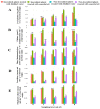Defense Mechanisms Induced by Celery Seed Essential Oil against Powdery Mildew Incited by Podosphaera fusca in Cucumber
- PMID: 38248927
- PMCID: PMC10817264
- DOI: 10.3390/jof10010017
Defense Mechanisms Induced by Celery Seed Essential Oil against Powdery Mildew Incited by Podosphaera fusca in Cucumber
Abstract
This study aimed to evaluate the effectiveness of essential oil extracted from celery (Apium graveolens) seeds (CSEO) for the control of powdery mildew of cucumber (Cucumis sativus) incited by Podosphaera fusca and to investigate the metabolic and genetic defense mechanisms triggered by the treatment with this essential oil in cucumber seedlings. The main compounds in the CSEO as determined by gas chromatography-mass spectrometry (GC-MS) analysis were d-limonene, 3-butyl phthalide, β-selinene, and mandelic acid. The treatment with CSEO led to an increase in the content of both chlorophyll and phenolic/flavonoid compounds in cucumber leaves. In greenhouse tests, the application of CSEO reduced by 60% the disease severity on leaves of cucumber plants and stimulated the activity of defense-related enzymes such as β-1,3-glucanase, chitinase, phenylalanine ammonia-lyase, peroxidase, and polyphenol oxidase. Moreover, treatment with CSEO induced overexpression of β-1,3-glucanase, chitinase, and phenylalanine ammonia-lyase genes. A highly significant correlation was found between the β-1,3-glucanase, chitinase, and phenylalanine ammonia-lyase enzymatic activities and the relative expression of the corresponding encoding genes in both inoculated and non-inoculated cucumber seedlings treated with the essential oil. Overall, this study showed that CSEO is a promising eco-friendly candidate fungicide that can be exploited to control cucumber powdery mildew.
Keywords: Apium graveolens; Cucumis sativus; chitinase; chlorophyll; d-limonene; flavonoids; gene expression; phenols; phenylalanine ammonia-lyase; β-1,3-glucanase.
Conflict of interest statement
The authors declare no conflicts of interest.
Figures






Similar articles
-
Celery and Spinach Flavonoid-Rich Extracts Enhance Phytoalexin Production in Powdery Mildew-Infected Cucumber Leaves.Plants (Basel). 2025 Aug 4;14(15):2414. doi: 10.3390/plants14152414. Plants (Basel). 2025. PMID: 40805762 Free PMC article.
-
Celery flavonoid-rich extract significantly reduces cucumber powdery mildew severity and enhances plant defense responses.Sci Rep. 2025 Mar 27;15(1):10589. doi: 10.1038/s41598-025-95365-4. Sci Rep. 2025. PMID: 40148466 Free PMC article.
-
Changes in specific activities of peroxidase, chitinase and phenylalanine ammonia-lyase and phenolic content in cucumber leaves inoculated with Podosphaera fusca, the causal agent of powdery mildew.Commun Agric Appl Biol Sci. 2004;69(4):545-53. Commun Agric Appl Biol Sci. 2004. PMID: 15756838
-
Effects of Acibenzolar-S-methyl on the specific activities of peroxidase, chitinase and phenylalanine ammonia-lyase and phenolic content of host leaves in cucumber-powdery mildew interaction.Commun Agric Appl Biol Sci. 2004;69(4):555-63. Commun Agric Appl Biol Sci. 2004. PMID: 15756839
-
Chemistry, technology, and nutraceutical functions of celery (Apium graveolens L.): an overview.Crit Rev Food Sci Nutr. 2014;54(3):389-98. doi: 10.1080/10408398.2011.586740. Crit Rev Food Sci Nutr. 2014. PMID: 24188309 Review.
Cited by
-
Efficacy of Essential Oil Vapours in Reducing Postharvest Rots and Effect on the Fruit Mycobiome of Nectarines.J Fungi (Basel). 2024 May 8;10(5):341. doi: 10.3390/jof10050341. J Fungi (Basel). 2024. PMID: 38786695 Free PMC article.
-
Celery and Spinach Flavonoid-Rich Extracts Enhance Phytoalexin Production in Powdery Mildew-Infected Cucumber Leaves.Plants (Basel). 2025 Aug 4;14(15):2414. doi: 10.3390/plants14152414. Plants (Basel). 2025. PMID: 40805762 Free PMC article.
-
Effects of Far-Red Light and Ultraviolet Light-A on Growth, Photosynthesis, Transcriptome, and Metabolome of Mint (Mentha haplocalyx Briq.).Plants (Basel). 2024 Dec 14;13(24):3495. doi: 10.3390/plants13243495. Plants (Basel). 2024. PMID: 39771193 Free PMC article.
References
-
- Mostafa Y.S., Hashem M., Alshehri A.M., Alamri S., Eid E.M., Ziedan E.S.H., Alrumman S.A. Effective management of cucumber powdery mildew with essential oils. Agriculture. 2021;11:1177. doi: 10.3390/agriculture11111177. - DOI
-
- Sarhan E.A., Abd-Elsyed M.H., Ebrahiem A.M. Biological control of cucumber powdery mildew (Podosphaera xanthii) (Castagne) under greenhouse conditions. Egypt. J. Biol. Pest Control. 2020;30:65. doi: 10.1186/s41938-020-00267-4. - DOI
-
- Aqleem A. A report of powdery mildews on cucumbers in village nomal, Gilgit Baltistan (GB)–Pakistan. Clin. Biotechnol. Microbiol. 2017;1:99–104.
-
- Wahul S.M., Jagtap G.P., Rewale K.A., Bhosale R.P. Survey on powdery mildew of cucumber in Aurangabad and Jalna districts, India. Int. J. Curr. Microbiol. Appl. Sci. 2018;7:1618–1624. doi: 10.20546/ijcmas.2018.710.183. - DOI
Grants and funding
LinkOut - more resources
Full Text Sources
Miscellaneous

